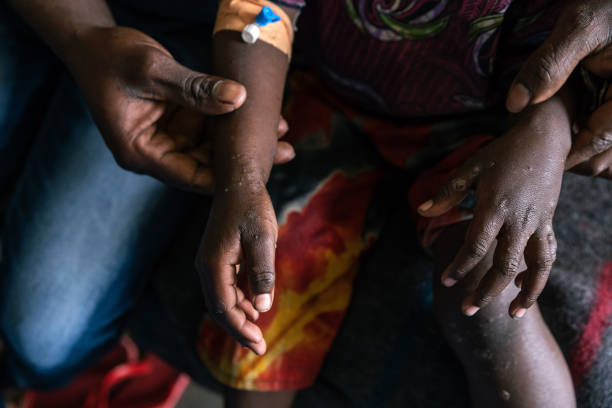The World Health Organization (WHO) has warned that children, pregnant women and people with weak immune systems are at higher risk from the mpox outbreak in the Democratic Republic of Congo. Reports confirm that children under five account for 39% of all cases in the country, and babies as young as two weeks are being diagnosed with this viral illness.
Nadia Adjoa Sam-Agudu, an expert in paediatric infectious diseases, explains how mpox can be dangerous for children and what must be done to protect them.
Why is the DRC outbreak affecting children so badly?
Because of conflict, political instability and insecurity, large parts of the DRC have not had stable, consistent, sustained health responses or health prevention. As a result, it’s hard to control infectious diseases like mpox.
In addition, children in any outbreak setting are already vulnerable given their immature and still-developing immune systems, especially under the age of five.
In a paper on paediatric mpox, my colleagues and I reported that children in Africa were much more vulnerable to monkeypox virus infection than children elsewhere. About 2% of those infected globally were under the age of 18 years, while children in Africa constituted nearly 40% of cases.
These statistics are due to a combination of things: living in a country where mpox is consistently present (endemic), exposure through contact with animals, and not having the benefit of a vaccine. Smallpox vaccine is effective against mpox, but this was discontinued in 1980 after smallpox was eradicated, so anyone born after that in DRC or other African countries has not been vaccinated against mpox. This is still true, even after the global outbreak.
The new variant circulating in the DRC – Clade Ib – has genetic changes that have been linked to sustained human-to-human transmission, which is thought to be driving the current outbreaks in the DRC and east Africa. Furthermore, current WHO reports indicate that Clade Ib is also linked to sexual contact and is affecting mostly adults, especially men who have sex with men and sex workers.
It is Clade Ia, the previously known circulating virus, which is significantly affecting children. Of course, adolescents (those between 10 and 19 years) may be caught in the middle and represented in the case numbers for both Clade Ia and Ib.
But it’s important to note that children have been susceptible to mpox since the first ever reported case in the DRC in 1970. That particular case was a nine-month-old boy.
In those days, animal-to-human contact was a more common means of mpox transmission – after all, it is a zoonotic disease. Studies and reports suggest that, historically, children were more susceptible to mpox because of higher exposure to wild animals, for example different species of monkeys and rodents in rural and forest areas.
Is this unusual? Are there other diseases that children are more susceptible to?
No, it’s not unusual.
Children are born with immune systems that are still developing.
It’s when they get to around five years of age that they have had enough time and disease exposure (or vaccines) to make their immune systems more robust and build adequate immune protection.
Children in the DRC are particularly vulnerable to vaccine-preventable diseases because the country has quite low child vaccination rates. In 2021, approximately 19.1% of children in the DRC between 12 and 23 months had never been vaccinated for diseases such as pertussis (whooping cough); the ideal vaccine coverage is 95%.
This also means that children in the DRC are more susceptible to highly contagious and dangerous diseases, like measles. An outbreak or rise in cases of measles infection is an early indicator that a health system is broken. This is because measles control needs a very high level of herd immunity – when enough people in a population are immune to a disease, making it harder for the disease to spread to those who aren’t immune. Once immunisation levels drop – like in the setting of conflict or other humanitarian emergency – measles infections start popping up. Containing them requires immense catch-up vaccination efforts.
Chickenpox and malaria are other diseases that children are more susceptible to on account of their immature and still-developing immune systems.
What are the priorities to protect children in this outbreak?
First, children must be specifically targeted for protection. This is because they are a primary population of concern that can develop severe and fatal disease.
Second, the health system and healthcare workers must make it as easy as possible to get parents or caregivers to bring children in. This includes addressing the inconveniences of leaving their communities to seek care.
Third, the stigma connected to mpox must be addressed. Parents and caregivers may be reluctant to seek care because of the stigma and negative treatment they may receive. The skin lesions are quite noticeable for mpox and unfortunately draw negative attention and treatment by society and health workers. The media, including international media, have been feeding into this – especially for African people with mpox – and it needs to stop.
Finally, a vaccination programme focused on children needs to be rolled out to stem transmission. But there are major challenges.
First, the mpox vaccine approved for use by the WHO and in most countries with access during the global 2022 outbreak and to date is the MVA-BN vaccine (Jynneos), which is not approved for children under 18 years. MVA-BN makes up the vast majority of ongoing vaccine donations to African countries. Japan’s LC16 vaccine has been used for children as young as 1-7 years, but it may require approvals for use or trials among children outside Japan.
In addition, children urgently need routine vaccines to protect them from other diseases such as measles, chickenpox, meningitis or polio. This will ensure that they aren’t struck by multiple illnesses while they are still highly vulnerable. It gives their immune system a better chance at fighting mpox.
What steps should be taken if a child is infected with mpox?
This may be hard to do, especially in the home, but the child should be isolated to minimise human to human transmission. There has been some promise of drugs that directly treat mpox infection, but recent results from tecovirimat and Clade I mpox have been disappointing.
The next step is to treat the symptoms and prevent complications. The most common manifestations in paediatric mpox are rash, fever and enlarged lymph nodes, and the most common cause of complications is secondary bacterial infection.
It’s particularly important that skin lesions are managed to prevent secondary infection. The danger is in mpox lesion infection.
If left unmanaged, the infection can develop into sepsis. This is a potentially fatal bloodstream infection that can affect the function of one or more organs. The reports of mortality among children in the DRC are usually sepsis. Proper wound care and antibiotics are important preventive tools.
In parallel to this, steps must be taken to help improve the overall health and well-being of the child. For instance, if the child is malnourished, they need age-appropriate therapeutic nutrition so that they are better able to fight mpox and other infections.
Children in mpox-endemic African countries are facing outbreaks with little to no access to paediatric vaccines and effective antiviral treatments. In this context, the most important things are nutrition, completion of routine immunisations, and prevention of secondary infection. This requires convenient access to stigma-free, evidence-based care and support to the children and their parents or caregivers.![]()
Nadia Adjoa Sam-Agudu, Professor, Pediatric Infectious Diseases and Director, Global Pediatrics Program global health, University of Minnesota
This article is republished from The Conversation under a Creative Commons license. Read the original article.











